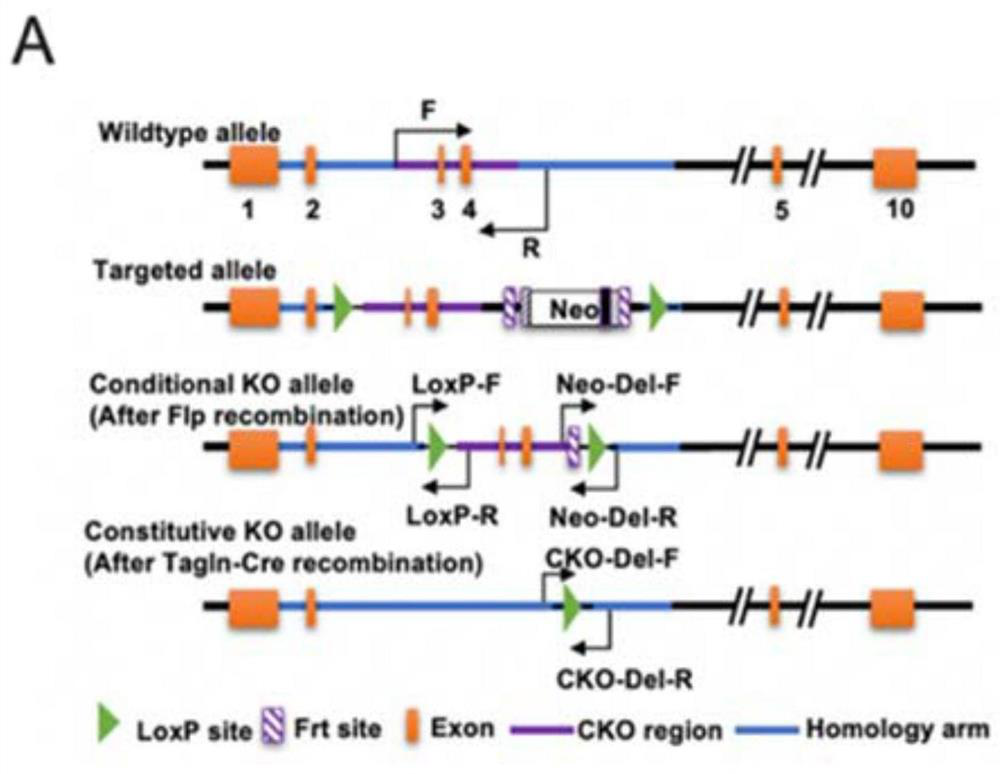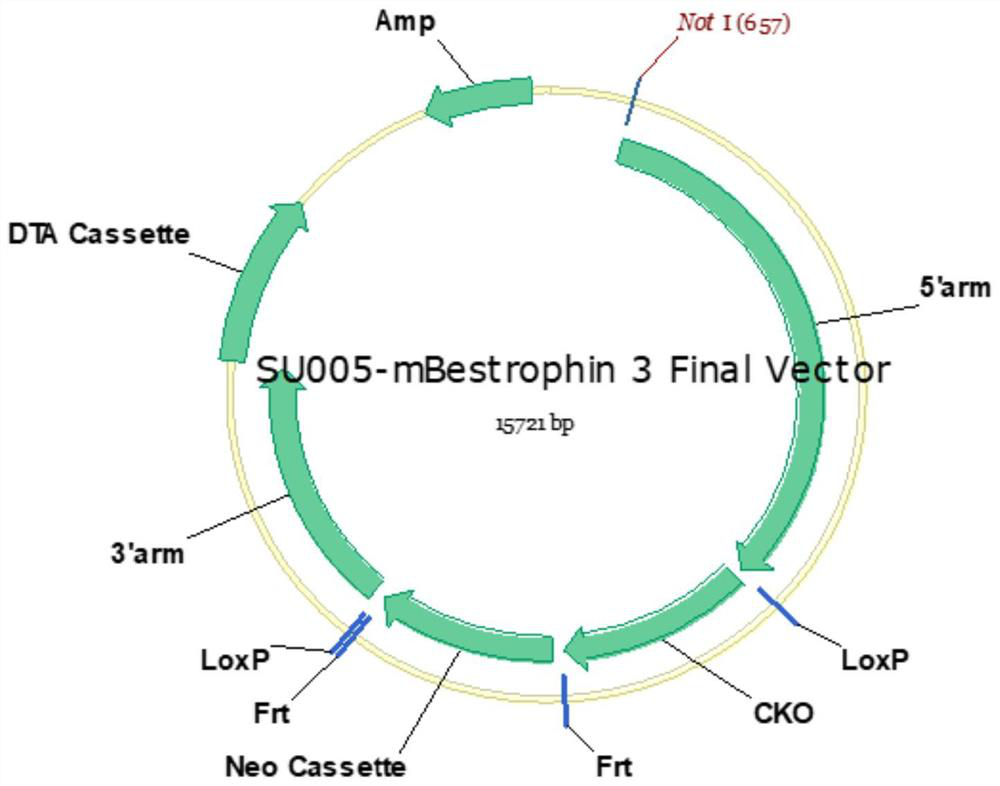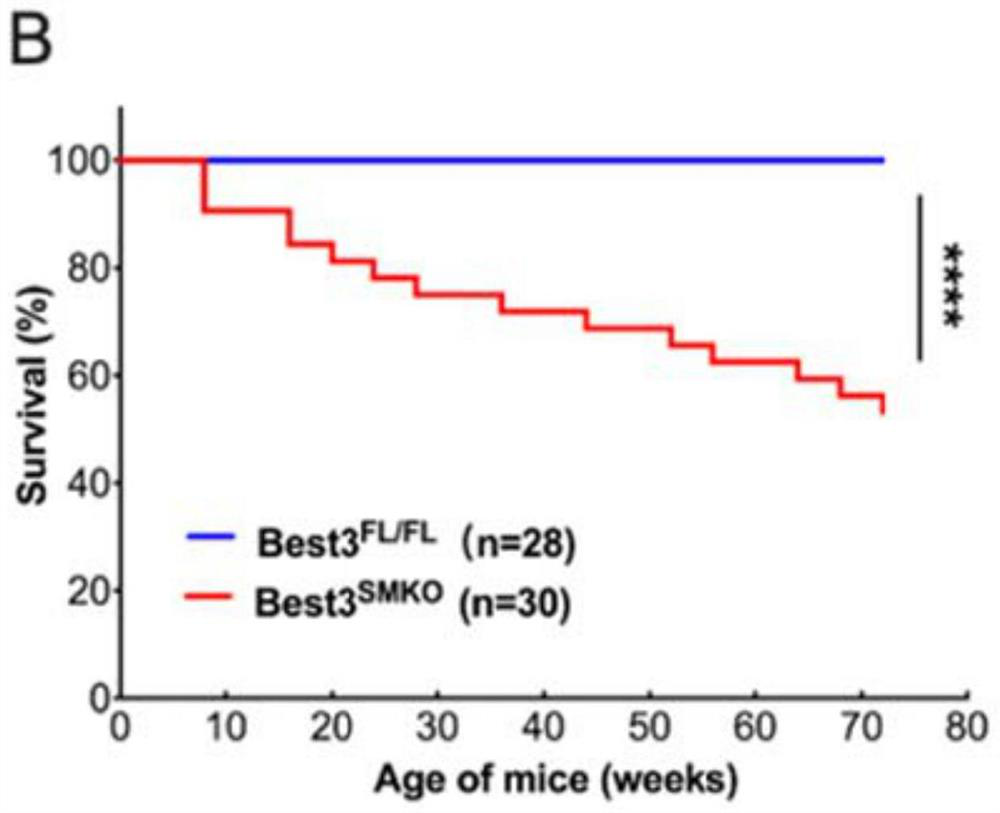Construction method of Bestrophin3 vascular smooth muscle specific gene knockout mouse and aortic dissection mouse model
A gene knockout mouse, vascular smooth muscle technology, applied in the fields of botany equipment and methods, biochemical equipment and methods, genetic engineering, etc., can solve the problem of large experimental loss, high mortality rate, and low molding rate of knockout mice and other problems, to achieve the effect of simple modeling and high morbidity
- Summary
- Abstract
- Description
- Claims
- Application Information
AI Technical Summary
Problems solved by technology
Method used
Image
Examples
Embodiment 1
[0046] The construction method of Bestrophin3-fLoxP mouse model specifically includes the following steps:
[0047] (1) Materials: The construction of Bestrophin3-flox mice (C57BL / 6 mice) was entrusted to Saiye Biotechnology Co., Ltd.; the B6.Cg-Tg(Tagln-cre)1Her / J mice used in the experiment were from The Jackson Laboratory; C57BL / 6 mice were obtained from Saiye Biotechnology Co., Ltd.; PCR identification kits were purchased from sigma company in the United States;
[0048] (2) Construction of plasmid vector:
[0049] like figure 1 As shown in the figure, the Cre / LoxP recombination system was used to construct conditional knockout mice. First, a conditional knockout vector of Bestrophin 3 was constructed. Bestrophin 3 gene has 10 exons, ATG is on exon 2, TAA is on exon 10, and Bestrophin 3 is selected. Exon 3 and exon 4 of the gene are used as knockout regions, and deletion of this region should result in loss of function of the mouse Bestrophin 3 gene. Using the C57BL / 6 m...
Embodiment 2
[0059] VerifyBest3 SMKO Mice can spontaneously form AD in the basal state: In order to clarify the role of Bestrophin3 in AD formation, the Cre / LoxP conditional gene targeting technology was used to construct and obtain Bestrophin3 vascular smooth muscle-specific knockout mice (Best3 SMKO ), using Best3 flox+ / + as a control group (Best3 FL / FL ).
[0060] Test procedure: Record Best3 in natural growth state SMKO and Best3 FL / FL The death of mice within 4-72 weeks of age was used to draw the survival curve; the inner diameter of the aorta was detected by ultrasound Doppler of live small animals, and the structural changes of the mouse blood vessels were further clarified by dissecting the blood vessels of the mice by anatomical methods, so as to jointly evaluate the Bestrophin3 Effects of smooth muscle knockout on mouse aortic dissection / aortic aneurysm.
[0061] Test results: as image 3 shown, in the process of rearing the mice, the Best3 SMKO Mice showed slow movement ...
Embodiment 3
[0063] Angiotensin II (Ang II) induces Best3 SMKO Tests for Hypertension and Aortic Dissection in Mice:
[0064] Elevated blood pressure is an important inducement for the development of aortic dissection. In order to simulate the pathological conditions of hypertension at the onset of clinical aortic dissection, 4-week-old mice were subcutaneously implanted with an Ang II sustained-release pump on the back to induce hypertension for 4 weeks. The induction flow diagram is as follows Figure 8 shown, including the following steps:
[0065] (1) To be Best3 FL / FL Mice and Best3 SMKO When the mice were 4 weeks old, two groups of mice from the same litterm were anesthetized by intraperitoneal injection of sodium pentobarbital (100 mg / kg). BW), a micro-osmotic sustained-release pump with Ang II solution (1.75 mg / kg) was implanted subcutaneously on the back, and the release rate of Ang II was 1.44 mg / kg / d. The systolic blood pressure (SBP) and diastolic blood pressure (DBP) of t...
PUM
 Login to View More
Login to View More Abstract
Description
Claims
Application Information
 Login to View More
Login to View More - R&D
- Intellectual Property
- Life Sciences
- Materials
- Tech Scout
- Unparalleled Data Quality
- Higher Quality Content
- 60% Fewer Hallucinations
Browse by: Latest US Patents, China's latest patents, Technical Efficacy Thesaurus, Application Domain, Technology Topic, Popular Technical Reports.
© 2025 PatSnap. All rights reserved.Legal|Privacy policy|Modern Slavery Act Transparency Statement|Sitemap|About US| Contact US: help@patsnap.com



